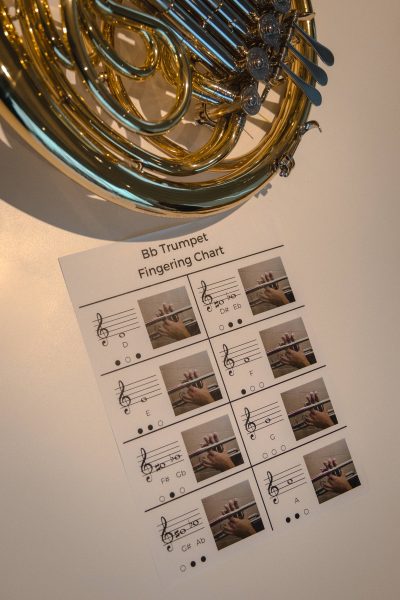
Last fall, Logan TeKolste (’23 music education) and her instrumental music education classmates were dismayed at the lack of beginning band materials for elementary students who speak English as a second language. After some investigation, TeKolste learned that some resources are available in Spanish, but not in other languages.
“If you look at the statistics, the Des Moines (Iowa) community schools alone serve students that speak over 100 primary languages. That didn’t sit right with me,” TeKolste said. “I’m like there’s got to be something that can be done.”
That’s when TeKolste’s double forte in music and innovation came together in perfect harmony.
Changing her tune
When TeKolste started college, she was solely focused on playing the French horn, participating in the Iowa State University Cyclone Football “Varsity” Marching Band, and obtaining her music education degree. She never considered pursuing entrepreneurial opportunities, until a marching band director nominated her for the College of Liberal Arts and Sciences’ Innovation and Entrepreneurship Academy, known as the I + E Academy.
“I went to the informational meeting and I had no idea what my project would be,” she said. “But it just felt like the right thing to try, so I joined.”
TeKolste’s first project with the academy was a joint effort with Iowa State and CYstarters alum Jacob Schmieder (’21 biochemistry, MS ’22 mechanical engineering), who launched Varsity Music, a company that incorporates lights onto musical instruments for both entertainment and educational purposes. She is still part of the Varsity Music team and serves as marketing director and director of educational applications.
During her second year with the academy, TeKolste sought out new endeavors. Armed with the knowledge that there are few beginning band materials for students who don’t speak English or Spanish, TeKolste began brainstorming creative ways to provide students with music education materials in their native languages. Her mission was to not only give all students the opportunity to learn a musical instrument, but to also provide a free resource for band teachers.
With the help of her I+E Academy mentor, Sarah Van Dusen, a lecturer in Iowa State’s music and theatre department, TeKolste mulled around several ideas before landing on the premise of language-less learning materials.
“What if there’s a way to explain how to play an instrument without using language at all because then it doesn’t matter what language you speak?” she said.
While there are a multitude of educational resources TeKolste could have pursued, she honed in on developing fingering charts that use pictures and diagrams, not words, to illustrate how to play all band instruments.
“I thought, what if there’s a picture of somebody holding the instrument next to the diagram in the beginning fingering charts so they can see what it looks like on a physical instrument with somebody actually playing the instrument?” TeKolste said.
A musical mission

With a plan in place, TeKolste wasted no time getting to work. She is methodically creating each diagram digitally with the help of a tablet.
“I’ve decided to make all my own diagrams so I don’t have to worry about anything with a copyright. So, I’m in the coloring phase, which is time-consuming but worth it,” she said.
TeKolste hopes to someday have the fingering charts readily available on a website or app so band instructors can easily access them – for free.
“My goal is to make it something teachers don’t have to pay to use because teachers already spend a lot of their own money buying things for students just to be able to teach,” TeKolste said. “I don’t want to make a profit off this. That’s not the point.”
A temporary ‘fermata’
For now, TeKolste has paused work on the fingering diagrams while she completes her first of two student teaching placements this semester. Currently, she is teaching at Valley South Woods Freshman High School in West Des Moines, Iowa, where she assists with the instrumental music ensembles, including concert band, jazz band, and pep band. She also teaches individual student lessons. Later this spring, she’ll move to the Ogden, Iowa, Community Schools to finish her student teaching placement.
So far, TeKolste “loves” her student teaching experience, especially getting to know the students and helping them discover their own musical journeys.
“There are kids who are in multiple ensembles and then there are other kids who just need to get their fine art credit out of the way,” she said. “It’s fun to work with them because even though they are not in band for the long haul, they are making the most of it.”
A dynamic duo
It might be unusual to connect music education and entrepreneurship. But for TeKolste, the two work in concert together.
“It surprised me how applicable I+E Academy is to education, not in the sense of traditional entrepreneurship and making money, but the innovation side,” she said. “A lot of the entrepreneurship skills transfer to teaching, especially music, where we are budgeting and doing all of the administration things, working across grade levels.”
When running a business, you have to constantly evaluate your goals, devise strategies to meet those goals, all while keeping a budget in mind. The same holds true for band instructors, TeKolste said, whose goals are to have students engaged and excited about the band program, even when other activities and responsibilities are vying for their attention.
“That kind of cost-analysis applies to band because your students are working on evaluating and prioritizing all of those things,” she said. “But for the health of the band program, you have to be able to support them through that.”
The show must go on
When TeKolste concludes student teaching later this spring, she will focus on landing her first job as a band instructor. She also intends to resurrect the fingering charts project, applying her practical teaching experiences to the overall plan.
“I knew going into this project that all of my ideas were from the perspective of somebody who has not actually taught yet,” she said. “The reality of teaching is that there are things that you want to do but you can’t.”
Another reality she counts on is that the I+E Academy and its director, Rebecca Runyon, are just a phone call or email away if she gets stuck.
“The academy gives you all the tools that you need for your project and supports you through it,” TeKolste said. “It’s one of the coolest things. Definitely a highlight of my undergrad career.”